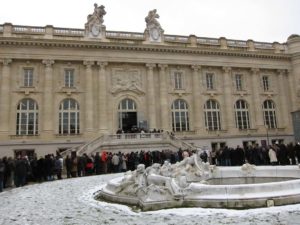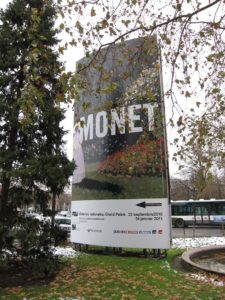 Put on your elbow and shoulder pads. Helmets not required (yet). Anyone who has lined up for a lift at a European Ski Resort, boarded a Tokyo subway at rush hour, or tried to go against the tide at Grand Central Station will know the feeling.
Put on your elbow and shoulder pads. Helmets not required (yet). Anyone who has lined up for a lift at a European Ski Resort, boarded a Tokyo subway at rush hour, or tried to go against the tide at Grand Central Station will know the feeling.
The massive Monet exhibit is one of the greatest gatherings of his work under one roof. It runs until January 24th, 2011. Tickets are sold out in Paris, but a few have been spotted at top concierges’ desks in the most expensive hotels. The masses who must see Monet without tickets can line up for hours in the cold, with hope that springs eternal to see the world’s most popular painter.
The exhibition entrance is on the side of the Grand Palais facing toward the Arc de Triomphe. The few who enter quickly realize they are not the only chosen ones. The coat check staff announce that there are no more hangers or lockers, and you’ll have to carry your bulky parka. (Remember: it’s about 0 degrees out and 85 degrees in. )
 The trick is patience. Spot your favorite Monet’s through the thicket of bodies. Slowly navigate closer. Get close enough to see the brushstrokes and layers of paint: something you cannot do looking at reproductions. Then, let the tide of viewers carry you like a bodysurfer to the next painter.
The trick is patience. Spot your favorite Monet’s through the thicket of bodies. Slowly navigate closer. Get close enough to see the brushstrokes and layers of paint: something you cannot do looking at reproductions. Then, let the tide of viewers carry you like a bodysurfer to the next painter.
But we’re here to learn about lighting and the synergy between Impressionism and the birth of cinema. Look for the three paintings of Paris railway stations with their luminously beautiful billowing clouds of noxiously polluting coal smoke. Here’s a clue to the technology that made the technique of Impressionist possible. Railroads could transport a painter from Paris onto locations in the countryside and back again in time for absinthe and dinner that evening. The main trick was to paint quickly—getting an “impression” of the scene. Previously, paintings meticulously done in the studio could take as long as necessary. Photography was also accelerating the process of making impressions.
Remember the railway scenes. We’ll get back to them when we visit the Lumiere Museum and discuss the birth of cinema.
www.grandpalais.fr








